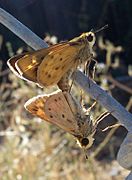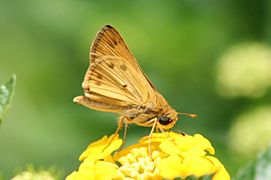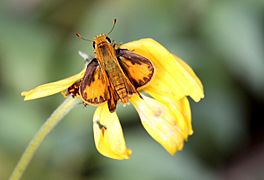Fiery skipper facts for kids
Quick facts for kids Fiery skipper |
|
|---|---|
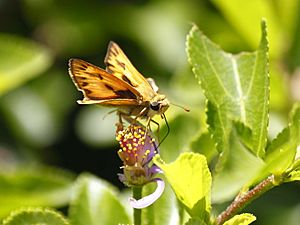 |
|
| Male | |
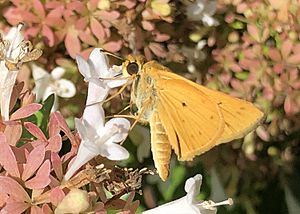 |
|
| In Oklahoma | |
| Conservation status | |
| Scientific classification | |
| Genus: |
Hylephila
|
| Species: |
phyleus
|
| Subspecies | |
|
|
The fiery skipper (Hylephila phyleus) is a small type of butterfly in the family Hesperiidae. It gets its name from its bright, fiery colors. These butterflies are about 1 inch (2.5 cm) long. Male fiery skippers are usually orange or yellow. Females are a darker brown. Both sexes can have small brown spots on their wings.
The young fiery skippers, called caterpillars or larvae, are greenish-pink-grey. They have a black head and a thin neck. These caterpillars often eat different types of grass, like Bermudagrass and St. Augustine grass. Sometimes, they are seen as pests because they can damage lawns.
Contents
Where Do Fiery Skippers Live?
The fiery skipper lives in many places across North and South America. You can find them from Canada all the way down to Argentina. In warmer months, some butterflies fly north. They can reach the northern United States and southern Ontario, Canada. Scientists think they might move to new places to find more food or mates. In 2012, a fiery skipper was even seen in New Brunswick, Canada. This shows they can travel very far!
How Do Fiery Skippers Behave?
Fiery skippers are known for how they hold their wings. They keep their front wings pointing up and their back wings folded flat. This makes a "triangle" shape. This special pose helps them soak up the sun's warmth.
These butterflies are very fast flyers. They move in quick, darting ways. This makes them hard to watch or catch! You can often find fiery skippers in cities and towns. They like areas with lots of grass, like lawns and parks. Studies have shown that their caterpillars grow best when they eat certain types of grass, like Bermuda Grass. Because they can live in so many different places, fiery skippers are very good at finding new homes when they have enough food.
Reproduction and Life Cycle
When a male fiery skipper wants to find a mate, he waits on a plant or blade of grass. He looks for a female to fly nearby. Males often choose spots where new female butterflies are likely to hatch. Their courtship is quick and can be interrupted by other males.
After mating, the female fiery skipper lays her eggs one by one. She places them in different spots. The eggs are small and clear white at first. They turn a pale blue after a few days. It takes about 23 to 24 days for a fiery skipper to grow from an egg to an adult butterfly. This happens when the temperature is around 27.5 to 29 degrees Celsius.
When the caterpillars hatch, they are green. Later, they become a dull grey color. They have a black head and a thin neck. Full-grown caterpillars can be up to 25 millimeters (1 inch) long. The pupa stage, where the caterpillar changes into a butterfly, takes about the same time for males and females. During this stage, the pupa changes from green to light brown.
Adult fiery skippers usually mate soon after they come out of their pupa. They live for about 6 to 11 days as adults. Scientists have studied the life cycle of the fiery skipper to understand it better.
Why Are Fiery Skippers Sometimes Pests?
The caterpillars of the fiery skipper can damage lawns and turfgrass. This has become a problem in places like California and Hawaii. Turfgrass is the term for grass that grows closely together, like on sports fields or in gardens. Other types of skipper butterflies can also be pests to plants like bananas.
Fiery skippers were first seen in Hawaii in 1970. Since then, they have spread to almost all the islands. On the island of Oahu, the fiery skipper is known as an invasive species. This means it is not native to the area and can cause harm. The main concern is that the caterpillars eat and damage turfgrass.
If there are too many fiery skipper caterpillars in a lawn, people might use special treatments to control them. For example, if you find about 15 caterpillars in a small area, it might be time to treat the grass. Some methods involve using special sprays to find out how many caterpillars are there. This helps experts decide if treatment is needed.
Images for kids
See also
 In Spanish: Hylephila phyleus para niños
In Spanish: Hylephila phyleus para niños



